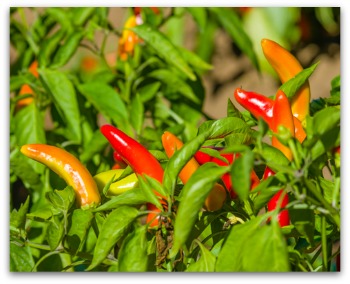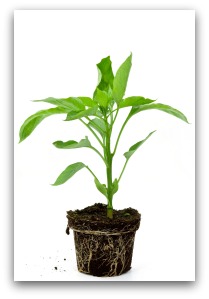Steps for Growing
Banana Peppers
Here are a few great tips for growing banana peppers in home vegetable gardens!
Learn easy steps for how to plant, care for, and harvest banana peppers in your garden.
Growing banana peppers, also called yellow wax peppers, are a member of the chili pepper family.
The banana pepper gets it name because its color and shape looks like a banana.
Banana peppers are usually yellow, but can also be red or orange colored.
The banana pepper has both sweet and hot varieties, depending on your preference.
In hot banana pepper varieties, the degree of hotness depends on the ripeness of the pepper.
With a mild to moderately hot flavor, banana peppers are often served pickled on sandwiches, in fresh garden salads, or seasoning for tasty recipes such as pepper steak.
Pickled banana peppers tend to taste similar to a sweet pickle that has been soaked in vinegar.
How to Grow Banana Peppers
The banana pepper plant requires full sun.
Pepper plants can be grown from transplants or seed.
Banana peppers are easy to grow and provide fresh peppers for many months during the summertime.
Here are vegetable gardening tips for growing banana peppers either in containers or conventional garden plots.
Download Free Garden Planning Worksheets, Garden Diary, Zone Chart, Or Planting Guide
Grow Banana Peppers in Container Gardens
Containers can include pots, window boxes, or five gallon buckets.
The larger the area allowed for the plants to grow increases the pepper production.
Ensure that whichever container you select has proper drainage.
Keep the soil moist for the best performance of the plant.
Mix fertilizer with potting soil to provide the plants with nutrients.
How to Grow Peppers
* Peppers can be finicky. They may not yield well if moisture levels or temperatures fluctuate too often. To avoid root rot, plant in well-drained soil.
* As you shop for transplants, look for strong stems and dark green leaves. Pass up plants with blossoms or fruit already growing, because these will not produce properly.
Spread thick but light mulch such as grass clippings or straw around pepper plants.
Water deeply during dry spells to encourage deep root development. Lack of moisture can produce bitter-tasting fruit.
* When weeding, gently pull weeds to avoid damaging pepper roots.
* Pale leaves and slow growth may indicate a need for liquid fertilizer such as manure tea.
Peppers grow best when soil is at least 60 degrees F. Temperatures over 90 degrees F. often cause blossoms to drop and plants to wilt.
To prevent this from happening, plant so that taller plants will shade peppers during the hottest hours.
Delaying Production when Growing Banana Peppers
In colder climates, there is a technique to delay fruit set for peppers with more pep.
Pick off all the flowers that bloom on your plants in early summer.
The 4th of July is an easy to remember date for beginning to let blossoms form fruits.
Using this vegetable gardening method, you allow the plant to grow a strong established root system before the plant turns its attention to producing peppers.
Plants will not only have a higher yield; peppers are also more resistant to plant diseases by delaying production.
Direct sunlight can cause sunscald to growing peppers. The scalded areas decay quickly.
Protecting peppers from this condition can be accomplished by spacing plants as closely as possible for the shade provided.
If your soil is fertile, you can space peppers as close as a foot to 18 inches.
Harvesting Banana Peppers
* At harvest time, instead of hand-picking, always cut peppers from plant to prevent damaging the plants due to pulling too hard.
Most peppers are their very best at maturity.
On the other hand, harvesting growing banana peppers before they fully ripen encourages the plant to continue producing.
When frost is forecast, pick all fruit or pull up plants by the roots and hang them in a dry, cool place indoors until peppers ripen.






